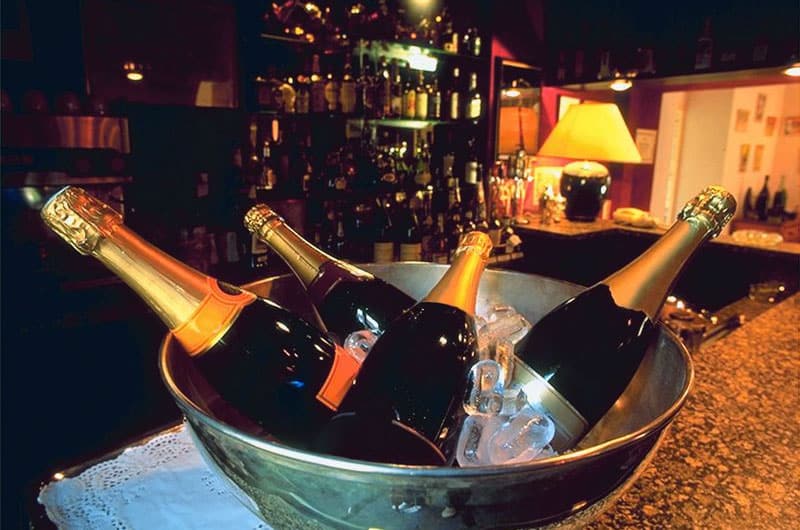~ by Jenny Benzie, Advanced Sommelier + Certified Wine Educator, Proprietress of Épernay Wine & Spirits ~
Bubbles, bubbles everywhere and there is plenty for you to drink! According to the calendar, it’s time to ramp up for some of the best holidays celebrated here on Nantucket. And what reads ‘celebration’ more than having a bottle of bubbly on hand for that impromptu gathering or last minute holiday gift?
While Christmas Day and New Year’s Eve (or if your birthday happens to be at some point in the last 6 weeks of the year) may require you to splurge on a special bottle of Champagne, there are plenty of other value options of sparkling wine available for your every day festivities that won’t have you reaching so far in your pockets that you have to touch your toes. Although this could be a good form of exercise during the holiday season, it is a regretful one and leads to a different type of New Year’s Resolution!
Here’s a rundown of a handful of options to help you sparkle through the New
Year:
Prosecco (pro-SECK-oh) is a dry sparkling wine made in the Veneto region of Northeast Italy. It is typically non-vintage meaning that the grapes used to make it are a blend of recent vintages and not from one specific year. Prosecco is similar to Champagne in that it comes from a highly regulated and governed zone in which only grapes grown in that specific area can be used to make Prosecco. The similarities and likeness of the two sparkling wines stop there, however. Prosecco is almost always made in the Charmat method, also known as the ‘tank’ method, in which the secondary fermentation that creates the bubbles is done in a large tank versus in individual bottles as in Champagne. The steel tanks, called autoclaves, are specially designed to withhold the pressure created in the bubble making and capture the fresh, fruitiness of the Glera grape used to make Prosecco, unlike the yeasty, rich style of Champagne. These wines range in style from Brut (the driest) to Extra Dry (which really means off-dry, so it is actually a confusingly slightly sweeter version) to Dry (the sweetest). If you are interested in a top level Prosecco, look for a Prosecco Superiore DOCG from the towns of Conegliano and Valdobbiadene or Asolo. Much to your dismay, you will not find a Pink Prosecco as they are not allowed in the region. If you find something pink and bubbly from Italy, it is typically labeled only as ‘spumante’ and not regulated in regards to production method, grapes used or the area in which the grapes are grown.
Recommended Wines: Lamberti Prosecco DOC NV, and Syltbar Premium Sparkling Rosé NV– made from 100% Merlot in the Veneto region and madelike Prosecco
Cava (KAH-vah) is a Spanish sparkling wine made in the same method as Champagne where the secondary fermentation that creates the bubbles is in the bottle. Here again also, the grapes must come from a demarcated area. But what makes Cava unique is that it is the only region that has several parcels spread throughout the country and not just one very specific zone. Most Cava is grown and produced in the Penedès region (south of Barcelona) and along the Ebro River valley (in Rioja). Cava can be made non-vintage or vintage and in the same array of styles as other sparkling wines (brut nature, brut, extra dry, dry). While Cava is made in the same method as Champagne, it a more economical option than the former as the entire production process is mechanized. The grapes that can be used to produce Cava include the indigenous Macabeo, Parellada and Xarel-lo, along with Chardonnay and sometimes Pinot Noir, Garnacha or Monastrell. Because a few of the allowable grapes are red, you are able to find Rosé Cava.
Recommended Wines: Clos Amador Brut Cava NV and Dibon Rosé Cava NV
Crémant – Not to be confused with the Grand Cru village of CRAMANT in the Champagne region, this term refers to a sparkling wine made in the same method as Champagne, but from another region in France. There are numerous styles of Crémant including the traditional Blanc, Blanc de Blancs (made only from white grapes), Blanc de Noirs (a white wine made only from red grapes) or Rosé.
Crémant de Bourgogne is typically white, although some rosé is made, and comes from the Burgundy region. It can be made from Chardonnay and Pinot Noir, with a small amount of Gamay Noir permissible by law along with Pinot Blanc, Pinot Gris, or Aligoté to fill out the remaining part of the blend.
Crémant d’Alsace hails from the Alsace region of France on the northeast border near Germany. This is usually made from a blend of white grapes, including Pinot Blanc, Pinot Gris, Pinot Noir, Auxerrois and Chardonnay. Because there is Pinot Noir grown in the region, you may find a Crémant d’Alsace rosé, but they are extremely rare.
Crémant de Loire found in the Loire Valley happens to be the largest producer of sparkling wine in France outside of the Champagne region. While numerous other grape varieties are permitted, sparkling wines from here are typically produced from a blend of Chardonnay, Chenin Blanc and Cabernet Franc.
Other regions of note that produce crémants include Bordeaux, Limoux (from the Languedoc), Jura, Savoie and even Luxembourg falls under the same production rules.
Recommended Wines: Pierre Sparr Crémant d’Alsace Brut Réserve NV and Lucien Albrecht Crémant d’Alsace Brut Rosé NV
While the sparkling wines of Prosecco, Cava and the various Crémants of France hold value for the quality that is apparent in the bottle, they are not meant to be aged and should be consumed when they are young and fresh. Concerned about opening another bottle for one more splash and have some leftover? Any of these selections will be a perfect addition to making a sparkling wine cocktail the next day. It is suggested, however, that you taste the sparkling wine first on its own to see its fruit characteristics and structure, then decide how to best mix it into a libation. The key to keeping it bubbly overnight is to continually keep it cold and never let it warm up, so best to store it in the fridge until its next use.
Cheers to you this Holiday Season and may you have a prosperous New Year!



